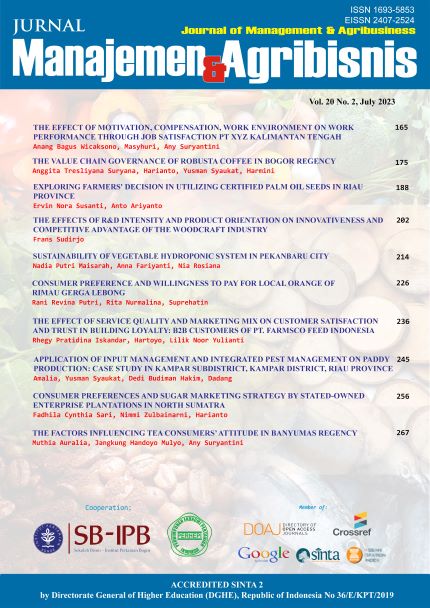The Effects of R&D Intensity and Product Orientation On Innovativeness and Competitive Advantage of The Woodcraft Industry
Abstract
The ever-evolving business environment demands companies to adopt a customer-focused culture, continuously develop and sustain growth. Marketing is seen as a fundamental aspect of corporate culture, with market orientation as its practical application. The purpose of this study is to identify product innovation influencing marketing performance in the woodcraft industry in Central Java, Indonesia by adding competitive advantage as a mediator variable. Factors leading to product innovation, such as environmental uncertainty and R&D intensity, as well as factors leading to competitive advantage, such as product orientation and customer orientation, are identified in this study. The population in this study were 214 timber companies in Central Java Province. By using simple random sampling, the number of samples used in this study were 110 samples. The analysis in this study uses the SEM analysis method with SmartPLS 3. The results of this study indicate that environmental uncertainty and R&D intensity affect product innovation. In addition, product innovation and competitive advantage also have an influence on marketing performance. Therefore, this study supports the contingency theory which states that environmental uncertainty and research and development intensity can affect product innovation. Companies can foster a culture of innovation that enables them to foresee and respond to customer needs more effectively by focusing on research and adapting to changes in the external environment.
Keywords: competitive advantage, environmental uncertainty, marketing performance, product orientation, R&D intensity
Authors
Authors who publish with this journal agree to the following terms:
- Authors retain copyright and grant the journal right of first publication with the work simultaneously licensed under a Creative Commons Attribution License that allows others to share the work with an acknowledgement of the work's authorship and initial publication in this journal.
- Authors are able to enter into separate, additional contractual arrangements for the non-exclusive distribution of the journal's published version of the work (e.g., post it to an institutional repository or publish it in a book), with an acknowledgement of its initial publication in this journal.
- Authors are permitted and encouraged to post their work online (e.g., in institutional repositories or on their website) prior to and during the submission process, as it can lead to productive exchanges, as well as earlier and greater citation of published work (See The Effect of Open Access).

